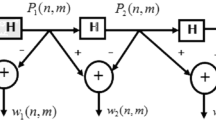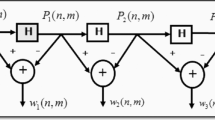Abstract
This paper presents a proposed approach for the enhancement of Infrared (IR) night vision images. This approach is based on a trilateral contrast enhancement in which the IR night vision images pass through three stages: segmentation, enhancement and sharpening. In the first stage, the IR image is divided into segments based on thresholding. The second stage, which is the heart of the enhancement approach, depends on additive wavelet transform (AWT) to decompose the image into an approximation and details. Homomorphic enhancement is performed on the detail components, while plateau histogram equalization is performed on the approximation plane. Then, the image is reconstructed and subjected to a post-processing high-pass filter. Average gradient, Sobel edge magnitude and spectral entropy are used as quality metrics for evaluation of the proposed approach. The used metrics ensure good success of this proposed approach.














Similar content being viewed by others
References
Alirezanejad M, Saffari V, Amirgholipour S, Sharifi AM (2014) Effect of locations of using high boost filtering on the watermark recovery in spatial domain watermarking. Indian J Sci Technol 7(4):517–524
Ashiba HI, Awadallah KH, El-Halfawy SM, El-Samie FEA (2008) Homomorphic enhancement of infrared images using the additive wavelet transform. Progress Electromagnet Res C 1:123–130
Deepa S, Bharathi VS (2013) Efficient ROI segmentation of digital mammogram images using Otsu’s N thresholding method. J Autom Artif Intell 1(2) ISSN: 2320-4001
Fan Z, Bi D, He L, Ma S (2016) Noise suppression and details enhancement for infrared image via novel prior. Infrared Phys Technol 74:44–52
Fan Z, Bi D, Ding W (2017) Infrared image enhancement with learned features. Infrared Phys Technol. https://doi.org/10.1016/j.infrared.2017.08.015
Gade R, Moeslund TB (2014) Thermal cameras and applications: a survey. Mach Vis Appl 25(1):245–262
Gonzalez RC, Woods RE (2002) Digital image processing: introduction; .
Gupta S, Mazumdar SG (2013) Sobel edge detection algorithm. Int J Comput Sci Manag Res 2(2) ISSN 2278-733X
Lan X, Ma AJ, Yuen PC (2014) Multi-cue visual tracking using robust feature-level fusion based on joint sparse representation: 1194-1201,CVPR
Lan X, Ma AJ, Yuen PC, Chellappa R (2015) Joint sparse representation and robust feature-level fusion for multi-Cue visual tracking. IEEE Trans Image Process 24(12):5826–5841. https://doi.org/10.1109/TIP.2015.2481325
Lan X, Zhang S, Yuen PC (2016) Robust joint discriminative feature learning for visual tracking. IJCAI: 3403-3410
Lan X, Yuen PC, Chellappa R (2017) Robust MIL-based feature template learning for object tracking. AAAI: 4118-4125
Lan X, Zhang S, Yuen PC, Chellappa R (2018) Learning common and feature-specific patterns: a novel multiple-sparse-representation-based tracker. IEEE Trans Image Process 27(4):2022–2037. https://doi.org/10.1109/TIP.2017.2777183
Lan X, Ye M, Zhang S, Yuen PC (2018) Robust collaborative discriminative learning for RGB-infrared tracking. AAAI:7008-7015
Lan X, Ye M, Zhang S, Zhou H, Yuen PC Modality-correlation-aware sparse representation for RGB-infrared object tracking. Pattern Recogn Lett. https://doi.org/10.1016/j.patrec.2018.10.002
Otsu N (1979) A threshold selection method from gray-level histograms. IEEE Trans Syst Man Cybernat 9(1):62–66
Pik Kong NS, Ibrahim H, Ooi CH, Juinn Chieh DC (2009) Enhancement of microscopic images using modified self-adaptive plateau histogram equalization. Int Conf Comput Technol 2:308–310
Qi Y, He R, Lin H (2016) Novel infrared image enhancement technology based on the frequency compensation approach. Infrared Phys Technol. https://doi.org/10.1016/j.infrared.2016.03.021
Song Q, Wang Y, Bai K (2016) High dynamic range infrared images detail enhancement based on local edge preserving filter. Infrared Phys Technol. https://doi.org/10.1016/j.infrared.2016.06.023
Taha M, H Hala, Zayed T, Nazmy Lalifa MK (2016) Day/night detector for vehicle tracking in traffic monitoring systems. Int J Comput Electr Auto Control Inform Eng 10(1)
Torabi A, Masse G, Bilodeau G-A (2012) An iterative integrated framework for thermal-visible image registration, sensor fusion, and people tracking for video surveillance applications. Comput Vis Image Underst 116(2):210–221
Wang Q, Ward RK (2007) Fast image/video contrast enhancement based on weighted threshold histogram equalization. IEEE Trans Consum Electron 53(2):757–764
Wang G, Xiao D, Gu J (2008) Review on vehicle detection based on video for traffic surveillance. IEEE Int Conf Auto Logist: 2961-2966
Wang J, Peng J, Feng X, He G, Fan J (2014) Fusion method for infrared and visible images by using non-negative sparse representation. Infrared Phys Technol 67:477–489
Wu Z, Fuller N, Theriault D, Betke M A thermal infrared video benchmark for visual analysis. http://www.vcipl.okstate.edu/otcbvs/bench/
Zhang Q, Maldague X (2016) An adaptive fusion approach for infrared and visible images based on NSCT and compressed sensing. Infrared Phys Technol 74:11–20
Zhang S, Li P, Xu X, Li L, Chang CC (2018) No-reference image blur assessment based on response function of singular values. Symmetry 10(304):2–15
Author information
Authors and Affiliations
Corresponding author
Additional information
Publisher’s note
Springer Nature remains neutral with regard to jurisdictional claims in published maps and institutional affiliations.
Rights and permissions
About this article
Cite this article
Ashiba, M.I., Tolba, M.S., El-Fishawy, A.S. et al. Hybrid enhancement of infrared night vision imaging system. Multimed Tools Appl 79, 6085–6108 (2020). https://doi.org/10.1007/s11042-019-7510-y
Received:
Revised:
Accepted:
Published:
Issue Date:
DOI: https://doi.org/10.1007/s11042-019-7510-y




